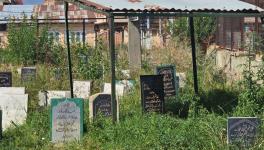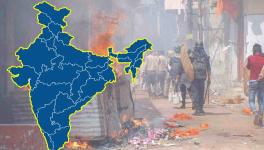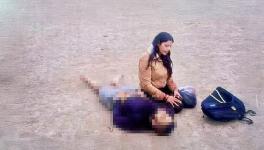‘Kashmir Civilian Killings Aim to Debunk India’s Normalcy Narrative’—Director of Military Think-Tank
The Sikh Light Infantry fought terrorism in Jammu and Kashmir under Maj Gen BK Sharma (Retd) AVSM, SM, who is currently director of the United Service Institution of India (USI), India’s oldest military think-tank. Jasvinder Sidhu spoke with him on the recent killings of civilian non-Kashmiris in the Valley. Maj Gen Sharma has very clear, even blunt, answers for the current situation in Kashmir. According to him, the attacks have created a scare and a political problem that the government must solve as Jammu and Kashmir is under Governor’s rule. He says the attacks are attempts to “debunk the Indian government’s narrative of peace and normalcy”. He also says that the situation in Kashmir does not merit an alarmist view.
Do you read any message in the recent civilian killings in Kashmir?
Absolutely. It is a message for the Indian state. The message is clear: don’t be utopian and think that Kashmir has stabilised. It very much remains on the boil. The message is that we [militants] have the capacity to hit out at soft targets at will, and therefore, the grandiose plans to get Kashmiri Pandits to the Valley and telling the world that stability has returned to Kashmir after [abrogation of Article] 370 is a myth. Therefore, these are acts done to debunk the Indian government’s narrative of peace and normalcy in the Valley.
So can we say these attacks are more against the narratives of ‘normalcy’ than the people?
Yes. They are challenging the narrative of normalcy. They are creating these sensational strikes to tell the world, the Indian government, and everybody else that Kashmir remains as destabilised and dangerous as it was prior to the abrogation of Article 370. They are conveying that they can attack at will. Therefore, it is just to show the Indian government and the security forces in poor light. Some symbolic success also emboldens and becomes a morale booster for militant cadres. Because, for them, it does not matter whether they have killed a commando or top police officer—as long as there is a fear psychosis and you create a media hype, their physiological purpose is served.
To be clear, who is at the receiving end of these messages—the people, the forces or the government?
As there is Governor’s rule in Jammu and Kashmir, the government must react following the fear created by these attacks. It is for the government to act if some government employee from Jammu refuses to work in Kashmir. If it has to take disciplinary action in such cases, there will be another cycle of resentment, creating dissidence. It will be more of a social and security problem. Anybody can ask the government, ‘You said you will rehabilitate the Kashmiri Pandits, but you are not even able to save those who are in the Valley!’ So, it will be more problematic for the Governor and administration.
As director of USI, what is your assessment of the current situation in Kashmir?
We have seen the worst of times—this is nothing by comparison. I have served in Jammu and Kashmir, I commanded the Sikh battalion there, and we saw the worst of circumstances. The present situation creates more problems for the CPO (Central Police Organisation) forces because today, the Army is not deployed in built-up areas or at population centres. The Army is mostly in layers at the Line of Control (LoC) and regions in the shadow of their deployment. It is creating more challenges for the government.
How alarming are these attacks for the forces serving in the Valley?
Security forces are quite immune to such killings....I lost three relatives in the Doda district who were in the armed forces...but definitely, it has created a scare and a political problem. For example, all the staff, like Jammu-based teachers posted in Kashmir, are returning. Some Kashmiri Pandits who had remained in the Valley are also leaving. The Sikhs had learned to live in harmony and had reached an accommodation of sorts, but following the killing of the woman principal, they, too, are scared.
The Resistance Front (TRF) took responsibility for the killing of non-Kashmiris. Is TRF a new threat for the region?
It is a ragtag force in the Valley. There is residual militancy or terrorism there, made of people who are without weapons or very short of firearms. They don’t have ammunition at this juncture. It is more of a hyperventilating kind of threat to create a sort of scare. So, I do not think it will play out or become a major uprising.
Is the Taliban’s return to power a new threat for Kashmir?
I don’t take an alarmist view on the situation in Jammu and Kashmir. A lot of water has flown under the bridge between 1996 and 2001. The time after the Taliban first came into power in Afghanistan was the peak of militancy and cross-border terrorism in Jammu and Kashmir. We were grappling with it in a big way then. Ever since then, there has been much capacity-building in our approach to fighting cross-border terrorism. So, I think we should not be unduly alarmed. I would say that this threat would manifest in terms of lone and stand-alone attacks to create a sensation, which anybody can do. And it can be attributed to the Afghanistan factor because the radical elements from both sides of the spectrum would like it to play out that way.
(Jasvinder Sidhu is an independent journalist.)
Get the latest reports & analysis with people's perspective on Protests, movements & deep analytical videos, discussions of the current affairs in your Telegram app. Subscribe to NewsClick's Telegram channel & get Real-Time updates on stories, as they get published on our website.
























